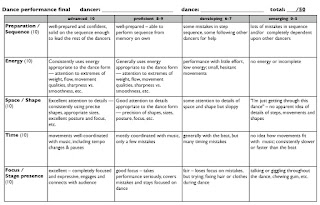In the course of the fall semester I developed a couple of new rubrics and put them to use. A good rubric can be invaluable in organizing your thinking to make the process of grading a physical art form as objective as possible. Over the years, I've come to realize that creating a rubric is an exercise in deciding what is important, what you truly care about seeing and consider excellent; and this process was certainly no exception.
The first new rubric was for performance tests. The rubric I had used and revised over many years had up to five categories (three or four for minor tests): Preparation/sequence, Energy, Technique, Musical timing, and Focus/stage presence. Here is that one:
As I was grading my spring performance finals, I grew more and more dissatisfied with the categories. "Preparation / sequence" was pretty straightforward (ranging from "solid enough to lead the rest of the dancers" to "lots of mistakes or completely dependent on other dancers"), as was "Focus" (taking into account things such as engaging with the audience, covering mistakes, and staying in character). But "Energy" felt a bit problematic, as "advanced" in that category — "full-out performance with excellent energy" — often seemed to be not quite what I was looking for in many dance styles. "High energy" would not come close to describing the subtle energy dynamics of 'auana hula, for just one example. So I started to think in terms of the dance element Energy and all it entails — smooth vs. sharp, weight, tension, flow, movement qualities — and moved that category more in the direction of using force and energy appropriate to the dance form.
I had also had trouble with the "Technique" category for years — I had started out including things like "clean lines, precise footwork, arms and legs stretched and feet pointed" as examples of attention to technical details, but ended up again feeling that my wording did not cover what I was looking for, as stretched arms and pointed feet are not necessarily a part of good technique in all dance forms. So I remembered something my mentor Patricia had said years ago (in relation to teaching creative work versus teaching technique): "after all, what is technique if not the elements of dance, applied?" That set me thinking that what we ordinarily think of as technical skill includes the energy dynamics and musical timing that I had broken out into separate categories... And then it started to click: so what was it that I was really looking for (what was important to me) in that category I called "technique"? Of course — shape! All those years, when grading "technique," I had really been most concerned with students creating the shapes appropriate for the dance form (which may include those pointed feet... or not). And if I started to think more broadly about Space, then amplitude, facings, and so many other things I had neglected to include would be covered...
From there, it was an easy jump to realizing that I simply needed to base my rubric on the elements of dance. It would still contain five categories, as the Preparation and Focus categories would remain; but the other three would reflect Space, Energy, and Time. Here is what I came up with:
I used the new rubric for all the fall semester performance finals, and it did work much better for me — no longer was I looking at details which seemed to fit into more than one category and having to decide where to note them. I found I could be much clearer in my thinking, now that I had acknowledged what I had really been looking at all along!
Of course, all rubrics are works in progress, so I will continue to refine this one...


No comments:
Post a Comment